Comprehensive Report: Managing a Successful Business Project in NHS
VerifiedAdded on 2023/01/18
|31
|6972
|58
Report
AI Summary
This report examines a project focused on managing equality and diversity within the National Health Service (NHS). It begins with an introduction highlighting the importance of equality and diversity, specifically addressing issues like gender pay gaps and sexual harassment within the NHS. The report outlines the aims and objectives of the project, which include identifying workplace issues, examining responses to these issues, and determining the impact of equality and diversity on employee performance. It includes a literature review on gender pay gaps and sexual harassment, followed by a detailed explanation of project management stages, from initiation to closure, and how they apply to the NHS. The report presents findings, conclusions, and recommendations based on small-scale research, data analysis, and thematic interpretations. The report also includes a reflection on the project and appendices containing questionnaires, log books, and performance reviews, offering a comprehensive analysis of the project and its outcomes.

Managing a Successful
Business Project
Business Project
Paraphrase This Document
Need a fresh take? Get an instant paraphrase of this document with our AI Paraphraser
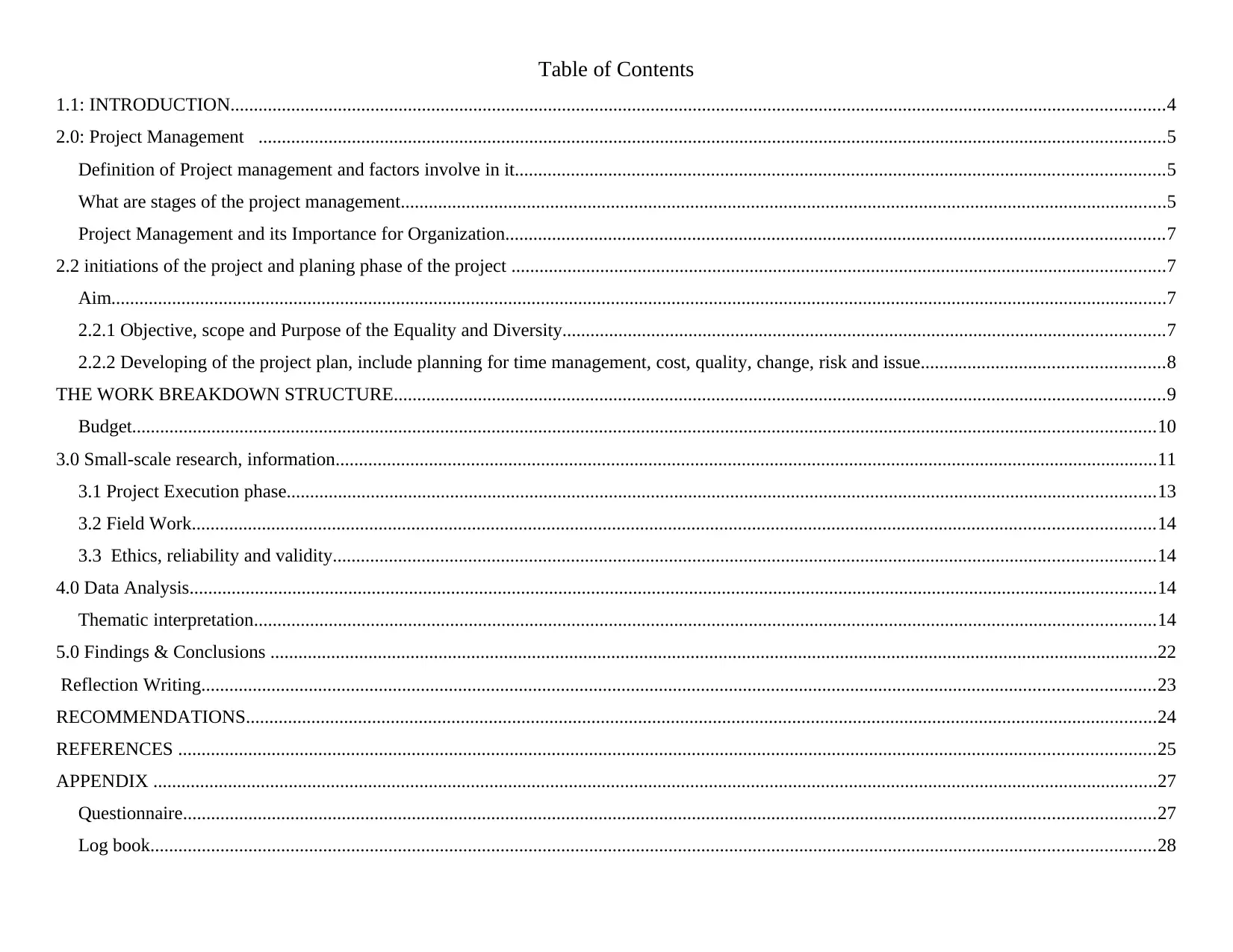
Table of Contents
1.1: INTRODUCTION........................................................................................................................................................................................................4
2.0: Project Management ..................................................................................................................................................................................................5
Definition of Project management and factors involve in it...........................................................................................................................................5
What are stages of the project management....................................................................................................................................................................5
Project Management and its Importance for Organization.............................................................................................................................................7
2.2 initiations of the project and planing phase of the project ............................................................................................................................................7
Aim..................................................................................................................................................................................................................................7
2.2.1 Objective, scope and Purpose of the Equality and Diversity.................................................................................................................................7
2.2.2 Developing of the project plan, include planning for time management, cost, quality, change, risk and issue....................................................8
THE WORK BREAKDOWN STRUCTURE.....................................................................................................................................................................9
Budget...........................................................................................................................................................................................................................10
3.0 Small-scale research, information................................................................................................................................................................................11
3.1 Project Execution phase..........................................................................................................................................................................................13
3.2 Field Work..............................................................................................................................................................................................................14
3.3 Ethics, reliability and validity................................................................................................................................................................................14
4.0 Data Analysis...............................................................................................................................................................................................................14
Thematic interpretation.................................................................................................................................................................................................14
5.0 Findings & Conclusions ..............................................................................................................................................................................................22
Reflection Writing............................................................................................................................................................................................................23
RECOMMENDATIONS...................................................................................................................................................................................................24
REFERENCES .................................................................................................................................................................................................................25
APPENDIX .......................................................................................................................................................................................................................27
Questionnaire................................................................................................................................................................................................................27
Log book.......................................................................................................................................................................................................................28
1.1: INTRODUCTION........................................................................................................................................................................................................4
2.0: Project Management ..................................................................................................................................................................................................5
Definition of Project management and factors involve in it...........................................................................................................................................5
What are stages of the project management....................................................................................................................................................................5
Project Management and its Importance for Organization.............................................................................................................................................7
2.2 initiations of the project and planing phase of the project ............................................................................................................................................7
Aim..................................................................................................................................................................................................................................7
2.2.1 Objective, scope and Purpose of the Equality and Diversity.................................................................................................................................7
2.2.2 Developing of the project plan, include planning for time management, cost, quality, change, risk and issue....................................................8
THE WORK BREAKDOWN STRUCTURE.....................................................................................................................................................................9
Budget...........................................................................................................................................................................................................................10
3.0 Small-scale research, information................................................................................................................................................................................11
3.1 Project Execution phase..........................................................................................................................................................................................13
3.2 Field Work..............................................................................................................................................................................................................14
3.3 Ethics, reliability and validity................................................................................................................................................................................14
4.0 Data Analysis...............................................................................................................................................................................................................14
Thematic interpretation.................................................................................................................................................................................................14
5.0 Findings & Conclusions ..............................................................................................................................................................................................22
Reflection Writing............................................................................................................................................................................................................23
RECOMMENDATIONS...................................................................................................................................................................................................24
REFERENCES .................................................................................................................................................................................................................25
APPENDIX .......................................................................................................................................................................................................................27
Questionnaire................................................................................................................................................................................................................27
Log book.......................................................................................................................................................................................................................28

Performance Review ....................................................................................................................................................................................................30
⊘ This is a preview!⊘
Do you want full access?
Subscribe today to unlock all pages.

Trusted by 1+ million students worldwide
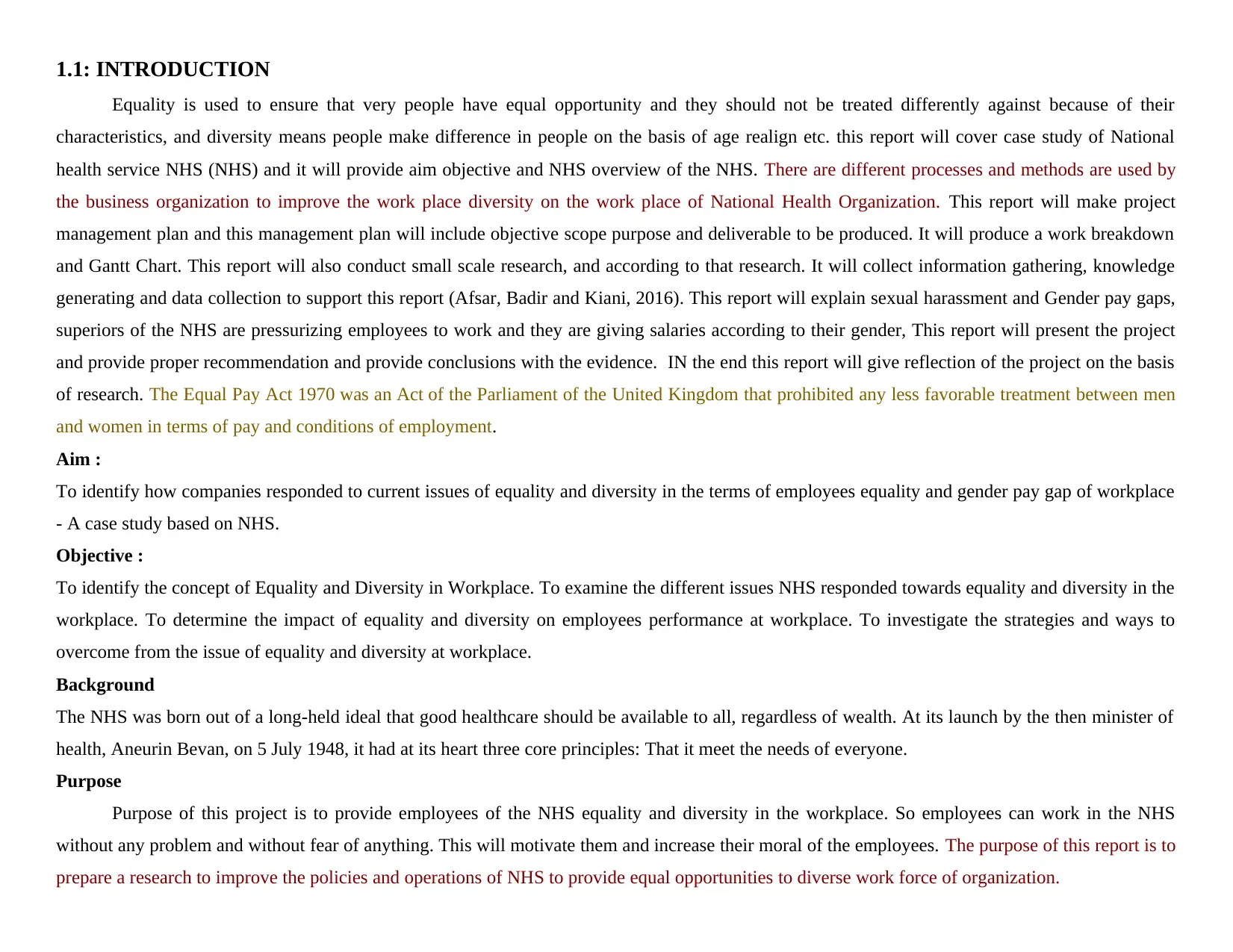
1.1: INTRODUCTION
Equality is used to ensure that very people have equal opportunity and they should not be treated differently against because of their
characteristics, and diversity means people make difference in people on the basis of age realign etc. this report will cover case study of National
health service NHS (NHS) and it will provide aim objective and NHS overview of the NHS. There are different processes and methods are used by
the business organization to improve the work place diversity on the work place of National Health Organization. This report will make project
management plan and this management plan will include objective scope purpose and deliverable to be produced. It will produce a work breakdown
and Gantt Chart. This report will also conduct small scale research, and according to that research. It will collect information gathering, knowledge
generating and data collection to support this report (Afsar, Badir and Kiani, 2016). This report will explain sexual harassment and Gender pay gaps,
superiors of the NHS are pressurizing employees to work and they are giving salaries according to their gender, This report will present the project
and provide proper recommendation and provide conclusions with the evidence. IN the end this report will give reflection of the project on the basis
of research. The Equal Pay Act 1970 was an Act of the Parliament of the United Kingdom that prohibited any less favorable treatment between men
and women in terms of pay and conditions of employment.
Aim :
To identify how companies responded to current issues of equality and diversity in the terms of employees equality and gender pay gap of workplace
- A case study based on NHS.
Objective :
To identify the concept of Equality and Diversity in Workplace. To examine the different issues NHS responded towards equality and diversity in the
workplace. To determine the impact of equality and diversity on employees performance at workplace. To investigate the strategies and ways to
overcome from the issue of equality and diversity at workplace.
Background
The NHS was born out of a long-held ideal that good healthcare should be available to all, regardless of wealth. At its launch by the then minister of
health, Aneurin Bevan, on 5 July 1948, it had at its heart three core principles: That it meet the needs of everyone.
Purpose
Purpose of this project is to provide employees of the NHS equality and diversity in the workplace. So employees can work in the NHS
without any problem and without fear of anything. This will motivate them and increase their moral of the employees. The purpose of this report is to
prepare a research to improve the policies and operations of NHS to provide equal opportunities to diverse work force of organization.
Equality is used to ensure that very people have equal opportunity and they should not be treated differently against because of their
characteristics, and diversity means people make difference in people on the basis of age realign etc. this report will cover case study of National
health service NHS (NHS) and it will provide aim objective and NHS overview of the NHS. There are different processes and methods are used by
the business organization to improve the work place diversity on the work place of National Health Organization. This report will make project
management plan and this management plan will include objective scope purpose and deliverable to be produced. It will produce a work breakdown
and Gantt Chart. This report will also conduct small scale research, and according to that research. It will collect information gathering, knowledge
generating and data collection to support this report (Afsar, Badir and Kiani, 2016). This report will explain sexual harassment and Gender pay gaps,
superiors of the NHS are pressurizing employees to work and they are giving salaries according to their gender, This report will present the project
and provide proper recommendation and provide conclusions with the evidence. IN the end this report will give reflection of the project on the basis
of research. The Equal Pay Act 1970 was an Act of the Parliament of the United Kingdom that prohibited any less favorable treatment between men
and women in terms of pay and conditions of employment.
Aim :
To identify how companies responded to current issues of equality and diversity in the terms of employees equality and gender pay gap of workplace
- A case study based on NHS.
Objective :
To identify the concept of Equality and Diversity in Workplace. To examine the different issues NHS responded towards equality and diversity in the
workplace. To determine the impact of equality and diversity on employees performance at workplace. To investigate the strategies and ways to
overcome from the issue of equality and diversity at workplace.
Background
The NHS was born out of a long-held ideal that good healthcare should be available to all, regardless of wealth. At its launch by the then minister of
health, Aneurin Bevan, on 5 July 1948, it had at its heart three core principles: That it meet the needs of everyone.
Purpose
Purpose of this project is to provide employees of the NHS equality and diversity in the workplace. So employees can work in the NHS
without any problem and without fear of anything. This will motivate them and increase their moral of the employees. The purpose of this report is to
prepare a research to improve the policies and operations of NHS to provide equal opportunities to diverse work force of organization.
Paraphrase This Document
Need a fresh take? Get an instant paraphrase of this document with our AI Paraphraser
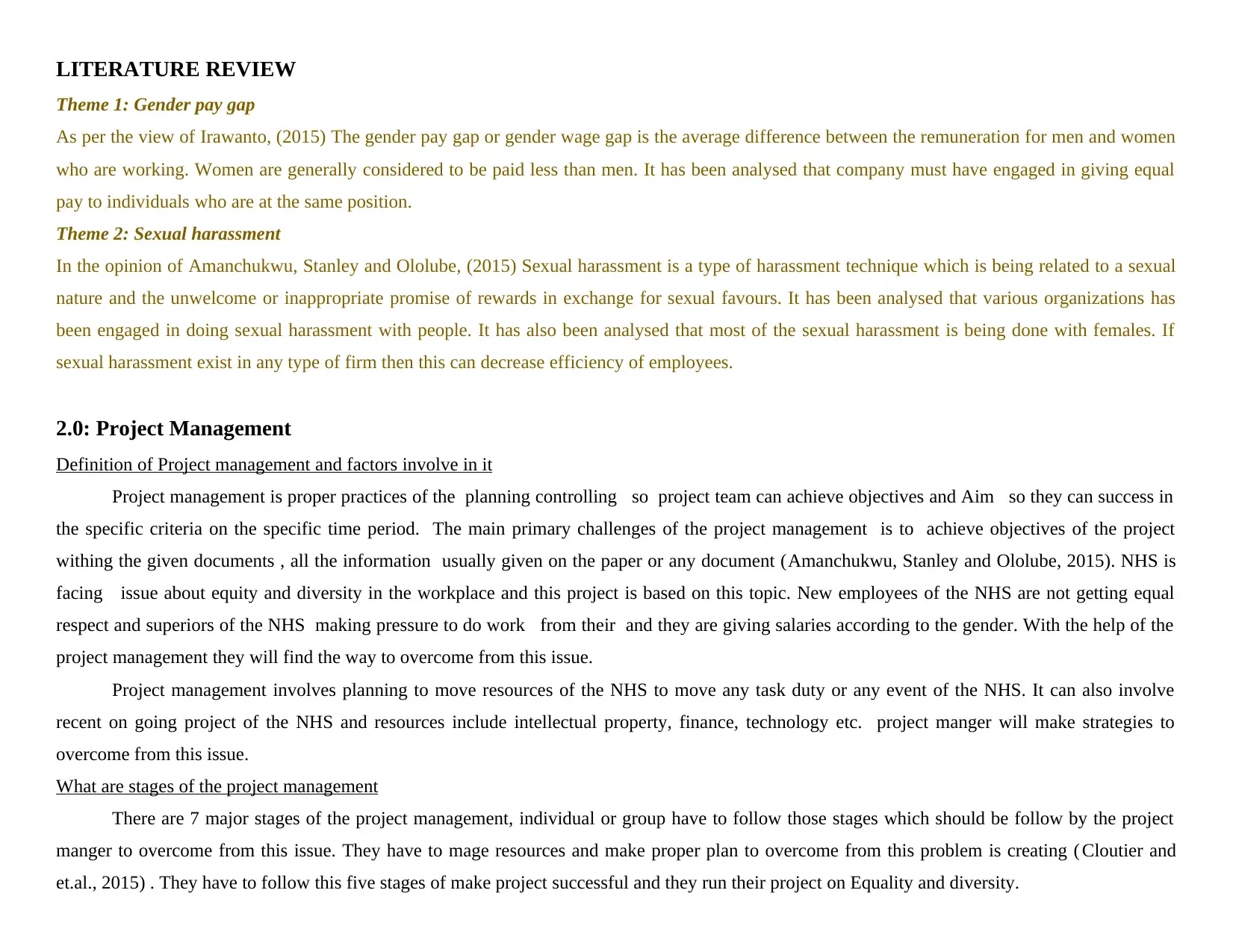
LITERATURE REVIEW
Theme 1: Gender pay gap
As per the view of Irawanto, (2015) The gender pay gap or gender wage gap is the average difference between the remuneration for men and women
who are working. Women are generally considered to be paid less than men. It has been analysed that company must have engaged in giving equal
pay to individuals who are at the same position.
Theme 2: Sexual harassment
In the opinion of Amanchukwu, Stanley and Ololube, (2015) Sexual harassment is a type of harassment technique which is being related to a sexual
nature and the unwelcome or inappropriate promise of rewards in exchange for sexual favours. It has been analysed that various organizations has
been engaged in doing sexual harassment with people. It has also been analysed that most of the sexual harassment is being done with females. If
sexual harassment exist in any type of firm then this can decrease efficiency of employees.
2.0: Project Management
Definition of Project management and factors involve in it
Project management is proper practices of the planning controlling so project team can achieve objectives and Aim so they can success in
the specific criteria on the specific time period. The main primary challenges of the project management is to achieve objectives of the project
withing the given documents , all the information usually given on the paper or any document (Amanchukwu, Stanley and Ololube, 2015). NHS is
facing issue about equity and diversity in the workplace and this project is based on this topic. New employees of the NHS are not getting equal
respect and superiors of the NHS making pressure to do work from their and they are giving salaries according to the gender. With the help of the
project management they will find the way to overcome from this issue.
Project management involves planning to move resources of the NHS to move any task duty or any event of the NHS. It can also involve
recent on going project of the NHS and resources include intellectual property, finance, technology etc. project manger will make strategies to
overcome from this issue.
What are stages of the project management
There are 7 major stages of the project management, individual or group have to follow those stages which should be follow by the project
manger to overcome from this issue. They have to mage resources and make proper plan to overcome from this problem is creating ( Cloutier and
et.al., 2015) . They have to follow this five stages of make project successful and they run their project on Equality and diversity.
Theme 1: Gender pay gap
As per the view of Irawanto, (2015) The gender pay gap or gender wage gap is the average difference between the remuneration for men and women
who are working. Women are generally considered to be paid less than men. It has been analysed that company must have engaged in giving equal
pay to individuals who are at the same position.
Theme 2: Sexual harassment
In the opinion of Amanchukwu, Stanley and Ololube, (2015) Sexual harassment is a type of harassment technique which is being related to a sexual
nature and the unwelcome or inappropriate promise of rewards in exchange for sexual favours. It has been analysed that various organizations has
been engaged in doing sexual harassment with people. It has also been analysed that most of the sexual harassment is being done with females. If
sexual harassment exist in any type of firm then this can decrease efficiency of employees.
2.0: Project Management
Definition of Project management and factors involve in it
Project management is proper practices of the planning controlling so project team can achieve objectives and Aim so they can success in
the specific criteria on the specific time period. The main primary challenges of the project management is to achieve objectives of the project
withing the given documents , all the information usually given on the paper or any document (Amanchukwu, Stanley and Ololube, 2015). NHS is
facing issue about equity and diversity in the workplace and this project is based on this topic. New employees of the NHS are not getting equal
respect and superiors of the NHS making pressure to do work from their and they are giving salaries according to the gender. With the help of the
project management they will find the way to overcome from this issue.
Project management involves planning to move resources of the NHS to move any task duty or any event of the NHS. It can also involve
recent on going project of the NHS and resources include intellectual property, finance, technology etc. project manger will make strategies to
overcome from this issue.
What are stages of the project management
There are 7 major stages of the project management, individual or group have to follow those stages which should be follow by the project
manger to overcome from this issue. They have to mage resources and make proper plan to overcome from this problem is creating ( Cloutier and
et.al., 2015) . They have to follow this five stages of make project successful and they run their project on Equality and diversity.
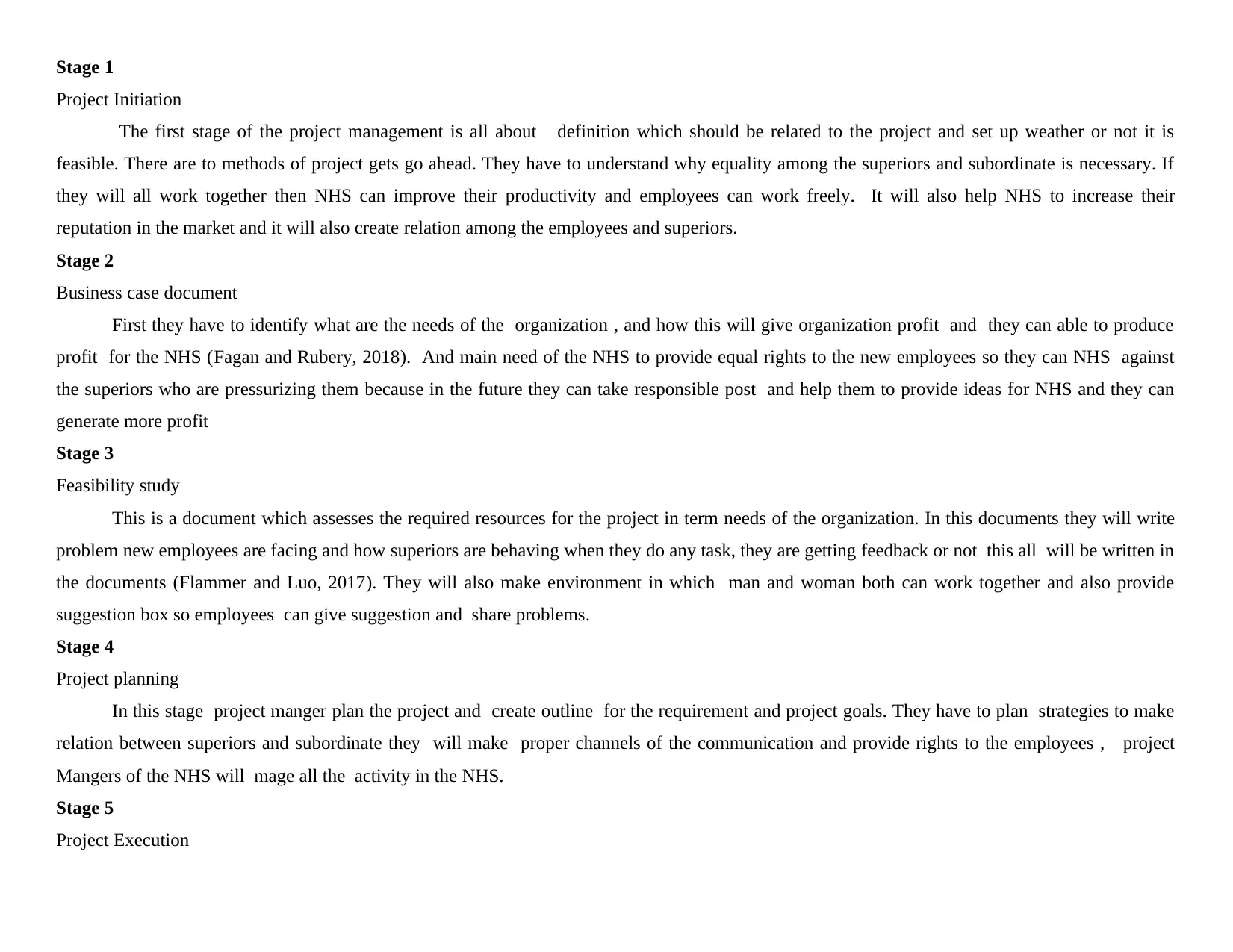
Stage 1
Project Initiation
The first stage of the project management is all about definition which should be related to the project and set up weather or not it is
feasible. There are to methods of project gets go ahead. They have to understand why equality among the superiors and subordinate is necessary. If
they will all work together then NHS can improve their productivity and employees can work freely. It will also help NHS to increase their
reputation in the market and it will also create relation among the employees and superiors.
Stage 2
Business case document
First they have to identify what are the needs of the organization , and how this will give organization profit and they can able to produce
profit for the NHS (Fagan and Rubery, 2018). And main need of the NHS to provide equal rights to the new employees so they can NHS against
the superiors who are pressurizing them because in the future they can take responsible post and help them to provide ideas for NHS and they can
generate more profit
Stage 3
Feasibility study
This is a document which assesses the required resources for the project in term needs of the organization. In this documents they will write
problem new employees are facing and how superiors are behaving when they do any task, they are getting feedback or not this all will be written in
the documents (Flammer and Luo, 2017). They will also make environment in which man and woman both can work together and also provide
suggestion box so employees can give suggestion and share problems.
Stage 4
Project planning
In this stage project manger plan the project and create outline for the requirement and project goals. They have to plan strategies to make
relation between superiors and subordinate they will make proper channels of the communication and provide rights to the employees , project
Mangers of the NHS will mage all the activity in the NHS.
Stage 5
Project Execution
Project Initiation
The first stage of the project management is all about definition which should be related to the project and set up weather or not it is
feasible. There are to methods of project gets go ahead. They have to understand why equality among the superiors and subordinate is necessary. If
they will all work together then NHS can improve their productivity and employees can work freely. It will also help NHS to increase their
reputation in the market and it will also create relation among the employees and superiors.
Stage 2
Business case document
First they have to identify what are the needs of the organization , and how this will give organization profit and they can able to produce
profit for the NHS (Fagan and Rubery, 2018). And main need of the NHS to provide equal rights to the new employees so they can NHS against
the superiors who are pressurizing them because in the future they can take responsible post and help them to provide ideas for NHS and they can
generate more profit
Stage 3
Feasibility study
This is a document which assesses the required resources for the project in term needs of the organization. In this documents they will write
problem new employees are facing and how superiors are behaving when they do any task, they are getting feedback or not this all will be written in
the documents (Flammer and Luo, 2017). They will also make environment in which man and woman both can work together and also provide
suggestion box so employees can give suggestion and share problems.
Stage 4
Project planning
In this stage project manger plan the project and create outline for the requirement and project goals. They have to plan strategies to make
relation between superiors and subordinate they will make proper channels of the communication and provide rights to the employees , project
Mangers of the NHS will mage all the activity in the NHS.
Stage 5
Project Execution
⊘ This is a preview!⊘
Do you want full access?
Subscribe today to unlock all pages.

Trusted by 1+ million students worldwide
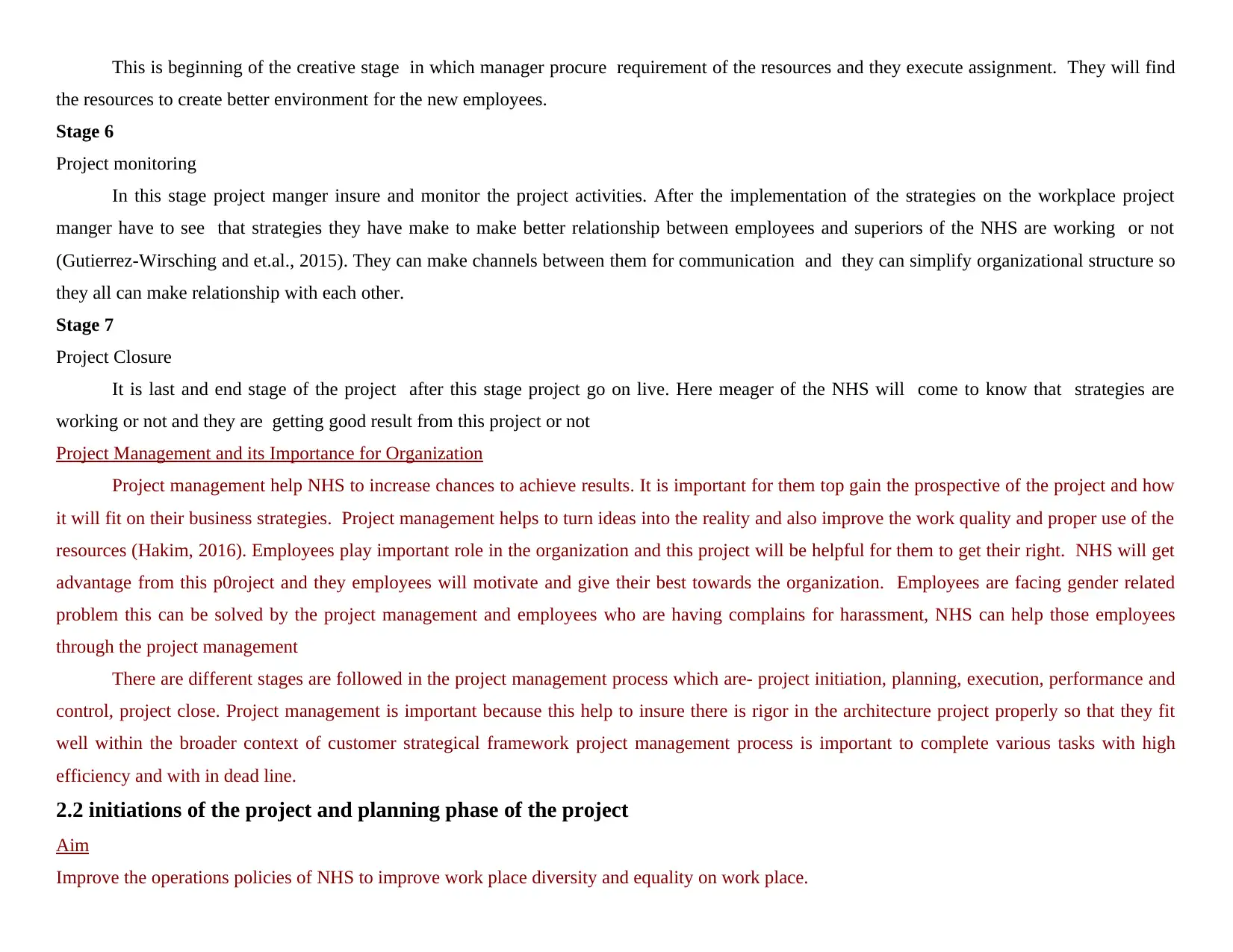
This is beginning of the creative stage in which manager procure requirement of the resources and they execute assignment. They will find
the resources to create better environment for the new employees.
Stage 6
Project monitoring
In this stage project manger insure and monitor the project activities. After the implementation of the strategies on the workplace project
manger have to see that strategies they have make to make better relationship between employees and superiors of the NHS are working or not
(Gutierrez-Wirsching and et.al., 2015). They can make channels between them for communication and they can simplify organizational structure so
they all can make relationship with each other.
Stage 7
Project Closure
It is last and end stage of the project after this stage project go on live. Here meager of the NHS will come to know that strategies are
working or not and they are getting good result from this project or not
Project Management and its Importance for Organization
Project management help NHS to increase chances to achieve results. It is important for them top gain the prospective of the project and how
it will fit on their business strategies. Project management helps to turn ideas into the reality and also improve the work quality and proper use of the
resources (Hakim, 2016). Employees play important role in the organization and this project will be helpful for them to get their right. NHS will get
advantage from this p0roject and they employees will motivate and give their best towards the organization. Employees are facing gender related
problem this can be solved by the project management and employees who are having complains for harassment, NHS can help those employees
through the project management
There are different stages are followed in the project management process which are- project initiation, planning, execution, performance and
control, project close. Project management is important because this help to insure there is rigor in the architecture project properly so that they fit
well within the broader context of customer strategical framework project management process is important to complete various tasks with high
efficiency and with in dead line.
2.2 initiations of the project and planning phase of the project
Aim
Improve the operations policies of NHS to improve work place diversity and equality on work place.
the resources to create better environment for the new employees.
Stage 6
Project monitoring
In this stage project manger insure and monitor the project activities. After the implementation of the strategies on the workplace project
manger have to see that strategies they have make to make better relationship between employees and superiors of the NHS are working or not
(Gutierrez-Wirsching and et.al., 2015). They can make channels between them for communication and they can simplify organizational structure so
they all can make relationship with each other.
Stage 7
Project Closure
It is last and end stage of the project after this stage project go on live. Here meager of the NHS will come to know that strategies are
working or not and they are getting good result from this project or not
Project Management and its Importance for Organization
Project management help NHS to increase chances to achieve results. It is important for them top gain the prospective of the project and how
it will fit on their business strategies. Project management helps to turn ideas into the reality and also improve the work quality and proper use of the
resources (Hakim, 2016). Employees play important role in the organization and this project will be helpful for them to get their right. NHS will get
advantage from this p0roject and they employees will motivate and give their best towards the organization. Employees are facing gender related
problem this can be solved by the project management and employees who are having complains for harassment, NHS can help those employees
through the project management
There are different stages are followed in the project management process which are- project initiation, planning, execution, performance and
control, project close. Project management is important because this help to insure there is rigor in the architecture project properly so that they fit
well within the broader context of customer strategical framework project management process is important to complete various tasks with high
efficiency and with in dead line.
2.2 initiations of the project and planning phase of the project
Aim
Improve the operations policies of NHS to improve work place diversity and equality on work place.
Paraphrase This Document
Need a fresh take? Get an instant paraphrase of this document with our AI Paraphraser
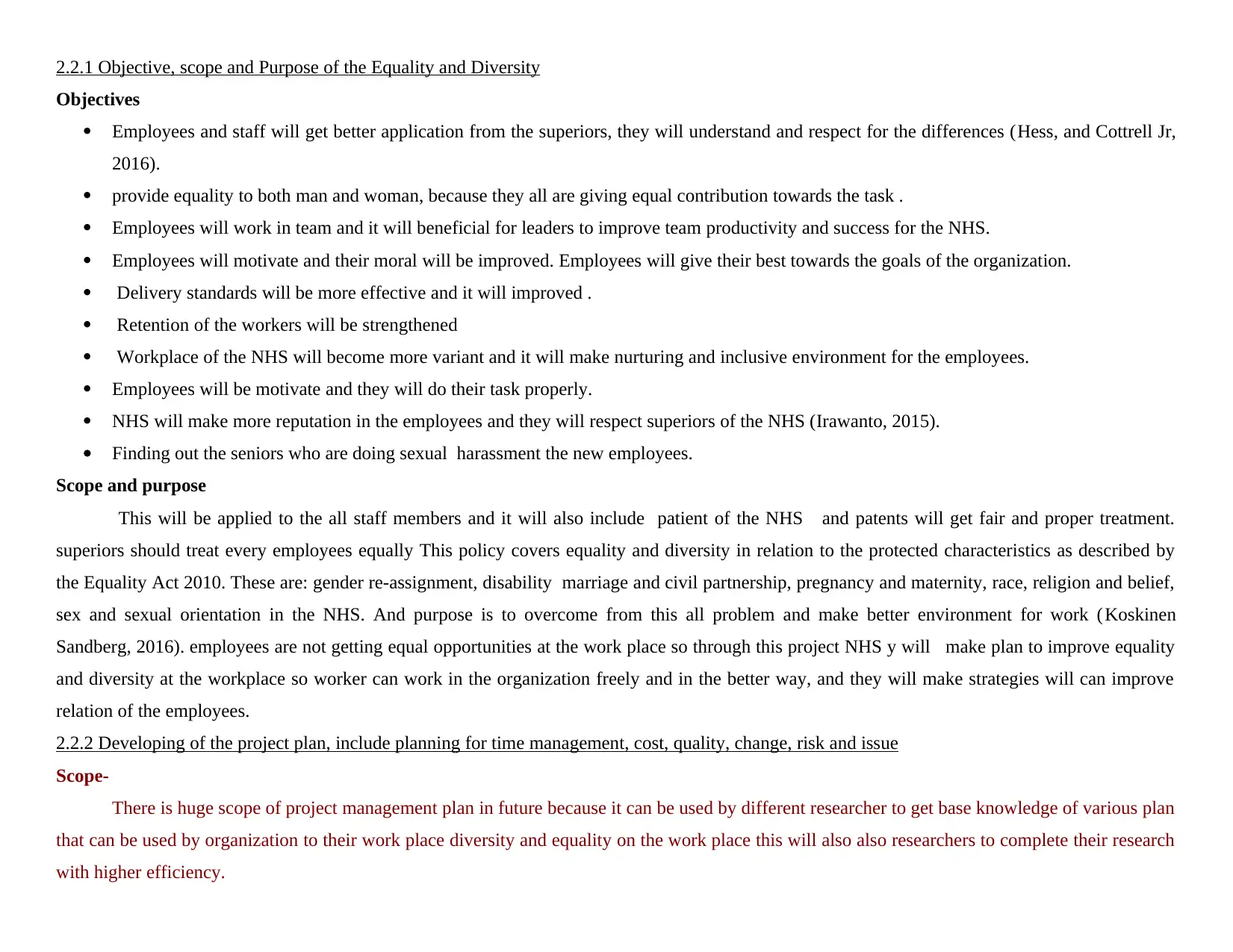
2.2.1 Objective, scope and Purpose of the Equality and Diversity
Objectives
Employees and staff will get better application from the superiors, they will understand and respect for the differences (Hess, and Cottrell Jr,
2016).
provide equality to both man and woman, because they all are giving equal contribution towards the task .
Employees will work in team and it will beneficial for leaders to improve team productivity and success for the NHS.
Employees will motivate and their moral will be improved. Employees will give their best towards the goals of the organization.
Delivery standards will be more effective and it will improved .
Retention of the workers will be strengthened
Workplace of the NHS will become more variant and it will make nurturing and inclusive environment for the employees.
Employees will be motivate and they will do their task properly.
NHS will make more reputation in the employees and they will respect superiors of the NHS (Irawanto, 2015).
Finding out the seniors who are doing sexual harassment the new employees.
Scope and purpose
This will be applied to the all staff members and it will also include patient of the NHS and patents will get fair and proper treatment.
superiors should treat every employees equally This policy covers equality and diversity in relation to the protected characteristics as described by
the Equality Act 2010. These are: gender re-assignment, disability marriage and civil partnership, pregnancy and maternity, race, religion and belief,
sex and sexual orientation in the NHS. And purpose is to overcome from this all problem and make better environment for work (Koskinen
Sandberg, 2016). employees are not getting equal opportunities at the work place so through this project NHS y will make plan to improve equality
and diversity at the workplace so worker can work in the organization freely and in the better way, and they will make strategies will can improve
relation of the employees.
2.2.2 Developing of the project plan, include planning for time management, cost, quality, change, risk and issue
Scope-
There is huge scope of project management plan in future because it can be used by different researcher to get base knowledge of various plan
that can be used by organization to their work place diversity and equality on the work place this will also also researchers to complete their research
with higher efficiency.
Objectives
Employees and staff will get better application from the superiors, they will understand and respect for the differences (Hess, and Cottrell Jr,
2016).
provide equality to both man and woman, because they all are giving equal contribution towards the task .
Employees will work in team and it will beneficial for leaders to improve team productivity and success for the NHS.
Employees will motivate and their moral will be improved. Employees will give their best towards the goals of the organization.
Delivery standards will be more effective and it will improved .
Retention of the workers will be strengthened
Workplace of the NHS will become more variant and it will make nurturing and inclusive environment for the employees.
Employees will be motivate and they will do their task properly.
NHS will make more reputation in the employees and they will respect superiors of the NHS (Irawanto, 2015).
Finding out the seniors who are doing sexual harassment the new employees.
Scope and purpose
This will be applied to the all staff members and it will also include patient of the NHS and patents will get fair and proper treatment.
superiors should treat every employees equally This policy covers equality and diversity in relation to the protected characteristics as described by
the Equality Act 2010. These are: gender re-assignment, disability marriage and civil partnership, pregnancy and maternity, race, religion and belief,
sex and sexual orientation in the NHS. And purpose is to overcome from this all problem and make better environment for work (Koskinen
Sandberg, 2016). employees are not getting equal opportunities at the work place so through this project NHS y will make plan to improve equality
and diversity at the workplace so worker can work in the organization freely and in the better way, and they will make strategies will can improve
relation of the employees.
2.2.2 Developing of the project plan, include planning for time management, cost, quality, change, risk and issue
Scope-
There is huge scope of project management plan in future because it can be used by different researcher to get base knowledge of various plan
that can be used by organization to their work place diversity and equality on the work place this will also also researchers to complete their research
with higher efficiency.
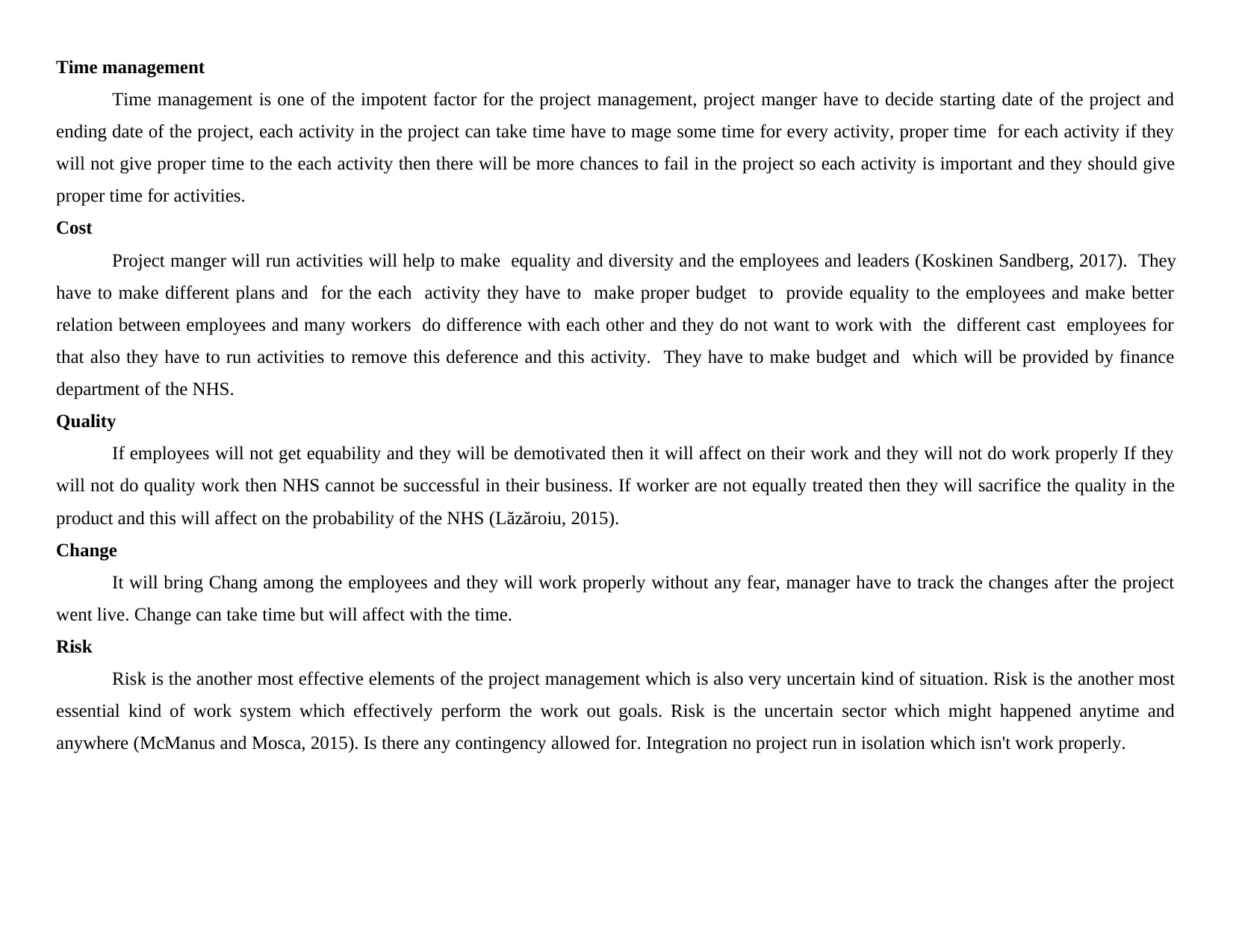
Time management
Time management is one of the impotent factor for the project management, project manger have to decide starting date of the project and
ending date of the project, each activity in the project can take time have to mage some time for every activity, proper time for each activity if they
will not give proper time to the each activity then there will be more chances to fail in the project so each activity is important and they should give
proper time for activities.
Cost
Project manger will run activities will help to make equality and diversity and the employees and leaders (Koskinen Sandberg, 2017). They
have to make different plans and for the each activity they have to make proper budget to provide equality to the employees and make better
relation between employees and many workers do difference with each other and they do not want to work with the different cast employees for
that also they have to run activities to remove this deference and this activity. They have to make budget and which will be provided by finance
department of the NHS.
Quality
If employees will not get equability and they will be demotivated then it will affect on their work and they will not do work properly If they
will not do quality work then NHS cannot be successful in their business. If worker are not equally treated then they will sacrifice the quality in the
product and this will affect on the probability of the NHS (Lăzăroiu, 2015).
Change
It will bring Chang among the employees and they will work properly without any fear, manager have to track the changes after the project
went live. Change can take time but will affect with the time.
Risk
Risk is the another most effective elements of the project management which is also very uncertain kind of situation. Risk is the another most
essential kind of work system which effectively perform the work out goals. Risk is the uncertain sector which might happened anytime and
anywhere (McManus and Mosca, 2015). Is there any contingency allowed for. Integration no project run in isolation which isn't work properly.
Time management is one of the impotent factor for the project management, project manger have to decide starting date of the project and
ending date of the project, each activity in the project can take time have to mage some time for every activity, proper time for each activity if they
will not give proper time to the each activity then there will be more chances to fail in the project so each activity is important and they should give
proper time for activities.
Cost
Project manger will run activities will help to make equality and diversity and the employees and leaders (Koskinen Sandberg, 2017). They
have to make different plans and for the each activity they have to make proper budget to provide equality to the employees and make better
relation between employees and many workers do difference with each other and they do not want to work with the different cast employees for
that also they have to run activities to remove this deference and this activity. They have to make budget and which will be provided by finance
department of the NHS.
Quality
If employees will not get equability and they will be demotivated then it will affect on their work and they will not do work properly If they
will not do quality work then NHS cannot be successful in their business. If worker are not equally treated then they will sacrifice the quality in the
product and this will affect on the probability of the NHS (Lăzăroiu, 2015).
Change
It will bring Chang among the employees and they will work properly without any fear, manager have to track the changes after the project
went live. Change can take time but will affect with the time.
Risk
Risk is the another most effective elements of the project management which is also very uncertain kind of situation. Risk is the another most
essential kind of work system which effectively perform the work out goals. Risk is the uncertain sector which might happened anytime and
anywhere (McManus and Mosca, 2015). Is there any contingency allowed for. Integration no project run in isolation which isn't work properly.
⊘ This is a preview!⊘
Do you want full access?
Subscribe today to unlock all pages.

Trusted by 1+ million students worldwide
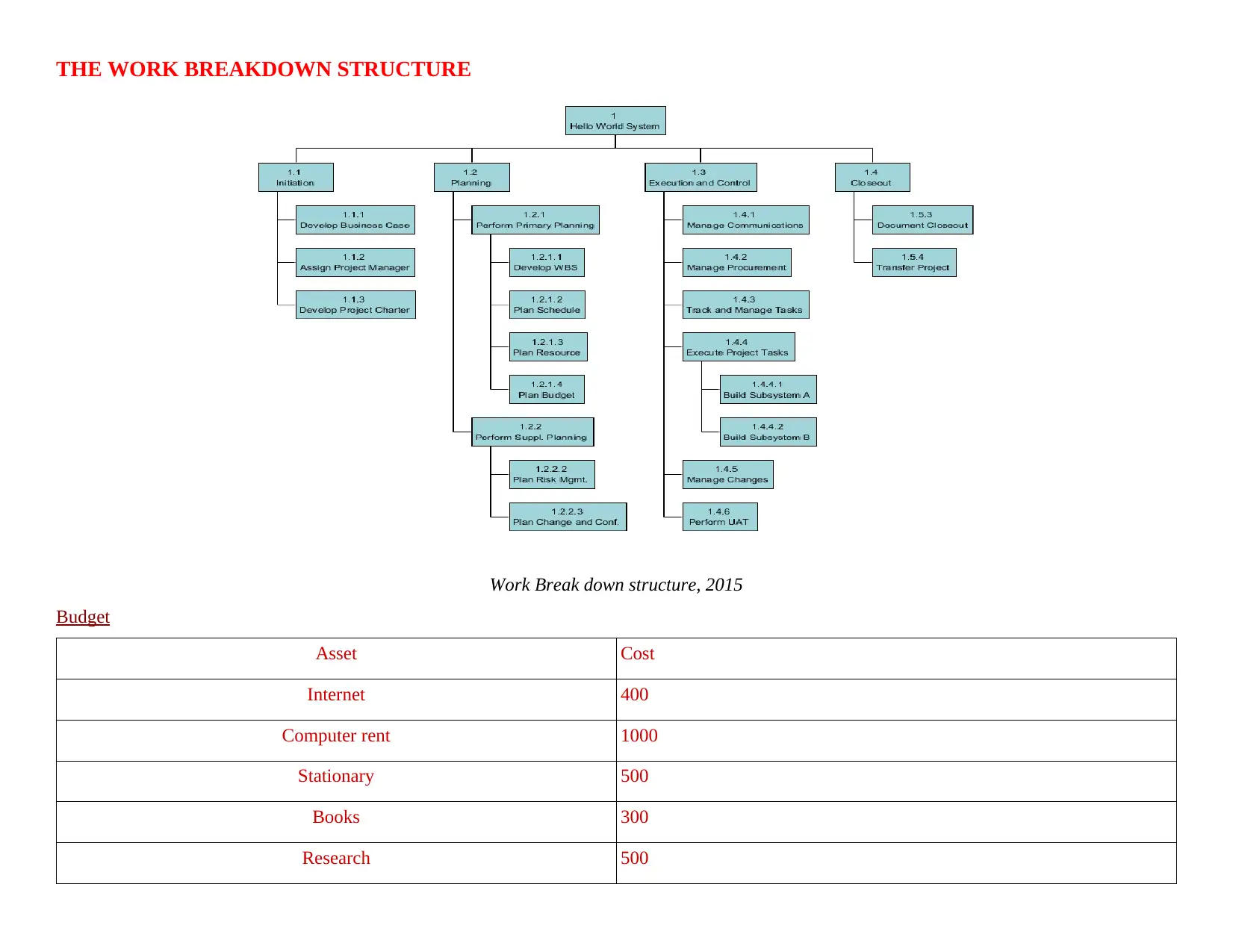
THE WORK BREAKDOWN STRUCTURE
Work Break down structure, 2015
Budget
Asset Cost
Internet 400
Computer rent 1000
Stationary 500
Books 300
Research 500
Work Break down structure, 2015
Budget
Asset Cost
Internet 400
Computer rent 1000
Stationary 500
Books 300
Research 500
Paraphrase This Document
Need a fresh take? Get an instant paraphrase of this document with our AI Paraphraser
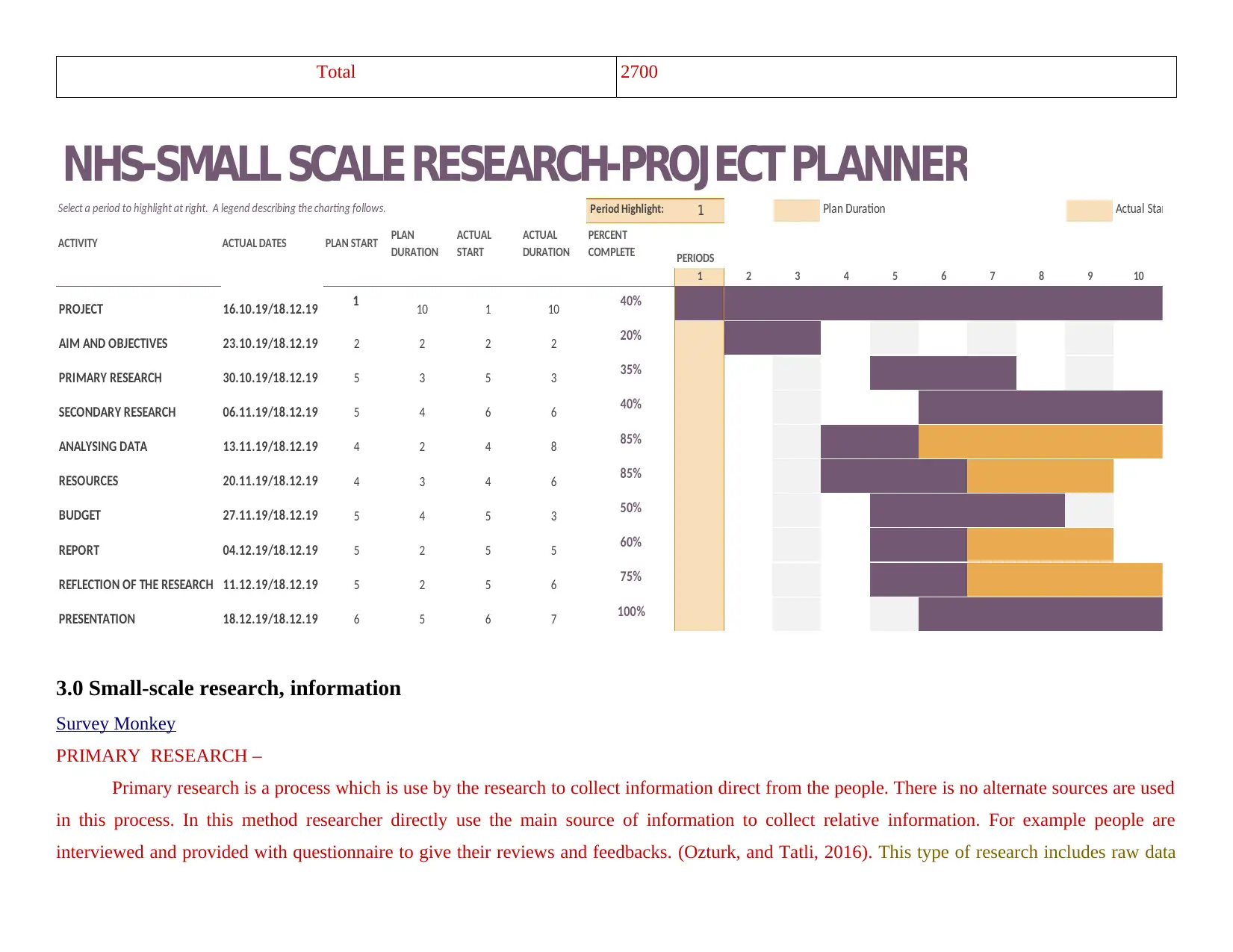
Total 2700
NHS-SMALL SCALE RESEARCH-PROJECT PLANNER
Period Highlight: 1 Actual Start
ACTIVITY ACTUAL DATES PLAN START PLAN
DURATION
ACTUAL
START
ACTUAL
DURATION
PERCENT
COMPLETE PERIODS
1 2 3 4 5 6 7 8 9 10
PROJECT 16.10.19/18.12.19 1 10 1 10 40%
AIM AND OBJECTIVES 23.10.19/18.12.19 2 2 2 2 20%
PRIMARY RESEARCH 30.10.19/18.12.19 5 3 5 3 35%
SECONDARY RESEARCH 06.11.19/18.12.19 5 4 6 6 40%
ANALYSING DATA 13.11.19/18.12.19 4 2 4 8 85%
RESOURCES 20.11.19/18.12.19 4 3 4 6 85%
BUDGET 27.11.19/18.12.19 5 4 5 3 50%
REPORT 04.12.19/18.12.19 5 2 5 5 60%
REFLECTION OF THE RESEARCH 11.12.19/18.12.19 5 2 5 6 75%
PRESENTATION 18.12.19/18.12.19 6 5 6 7 100%
Select a period to highlight at right. A legend describing the charting follows. Plan Duration
3.0 Small-scale research, information
Survey Monkey
PRIMARY RESEARCH –
Primary research is a process which is use by the research to collect information direct from the people. There is no alternate sources are used
in this process. In this method researcher directly use the main source of information to collect relative information. For example people are
interviewed and provided with questionnaire to give their reviews and feedbacks. (Ozturk, and Tatli, 2016). This type of research includes raw data
NHS-SMALL SCALE RESEARCH-PROJECT PLANNER
Period Highlight: 1 Actual Start
ACTIVITY ACTUAL DATES PLAN START PLAN
DURATION
ACTUAL
START
ACTUAL
DURATION
PERCENT
COMPLETE PERIODS
1 2 3 4 5 6 7 8 9 10
PROJECT 16.10.19/18.12.19 1 10 1 10 40%
AIM AND OBJECTIVES 23.10.19/18.12.19 2 2 2 2 20%
PRIMARY RESEARCH 30.10.19/18.12.19 5 3 5 3 35%
SECONDARY RESEARCH 06.11.19/18.12.19 5 4 6 6 40%
ANALYSING DATA 13.11.19/18.12.19 4 2 4 8 85%
RESOURCES 20.11.19/18.12.19 4 3 4 6 85%
BUDGET 27.11.19/18.12.19 5 4 5 3 50%
REPORT 04.12.19/18.12.19 5 2 5 5 60%
REFLECTION OF THE RESEARCH 11.12.19/18.12.19 5 2 5 6 75%
PRESENTATION 18.12.19/18.12.19 6 5 6 7 100%
Select a period to highlight at right. A legend describing the charting follows. Plan Duration
3.0 Small-scale research, information
Survey Monkey
PRIMARY RESEARCH –
Primary research is a process which is use by the research to collect information direct from the people. There is no alternate sources are used
in this process. In this method researcher directly use the main source of information to collect relative information. For example people are
interviewed and provided with questionnaire to give their reviews and feedbacks. (Ozturk, and Tatli, 2016). This type of research includes raw data
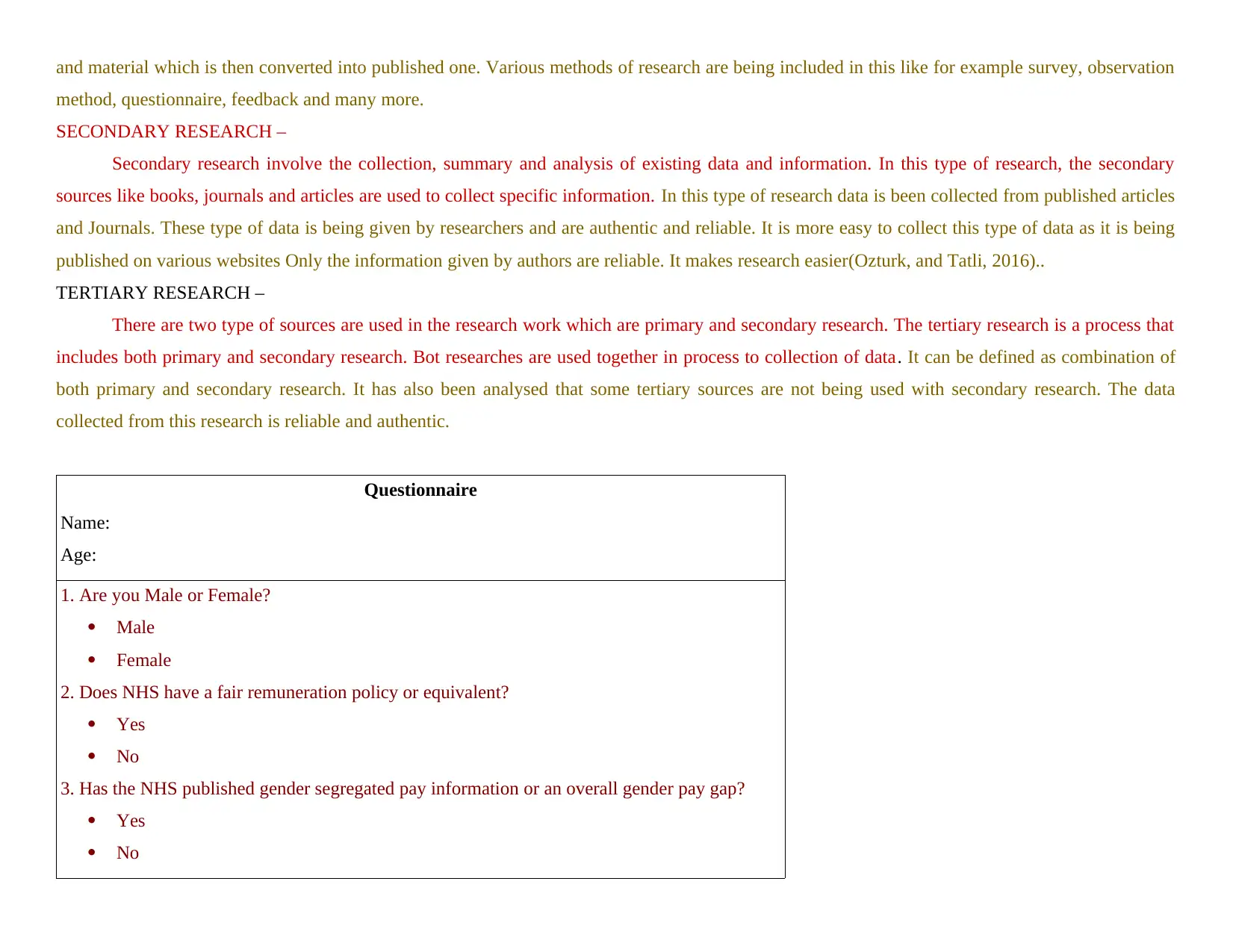
and material which is then converted into published one. Various methods of research are being included in this like for example survey, observation
method, questionnaire, feedback and many more.
SECONDARY RESEARCH –
Secondary research involve the collection, summary and analysis of existing data and information. In this type of research, the secondary
sources like books, journals and articles are used to collect specific information. In this type of research data is been collected from published articles
and Journals. These type of data is being given by researchers and are authentic and reliable. It is more easy to collect this type of data as it is being
published on various websites Only the information given by authors are reliable. It makes research easier(Ozturk, and Tatli, 2016)..
TERTIARY RESEARCH –
There are two type of sources are used in the research work which are primary and secondary research. The tertiary research is a process that
includes both primary and secondary research. Bot researches are used together in process to collection of data. It can be defined as combination of
both primary and secondary research. It has also been analysed that some tertiary sources are not being used with secondary research. The data
collected from this research is reliable and authentic.
Questionnaire
Name:
Age:
1. Are you Male or Female?
Male
Female
2. Does NHS have a fair remuneration policy or equivalent?
Yes
No
3. Has the NHS published gender segregated pay information or an overall gender pay gap?
Yes
No
method, questionnaire, feedback and many more.
SECONDARY RESEARCH –
Secondary research involve the collection, summary and analysis of existing data and information. In this type of research, the secondary
sources like books, journals and articles are used to collect specific information. In this type of research data is been collected from published articles
and Journals. These type of data is being given by researchers and are authentic and reliable. It is more easy to collect this type of data as it is being
published on various websites Only the information given by authors are reliable. It makes research easier(Ozturk, and Tatli, 2016)..
TERTIARY RESEARCH –
There are two type of sources are used in the research work which are primary and secondary research. The tertiary research is a process that
includes both primary and secondary research. Bot researches are used together in process to collection of data. It can be defined as combination of
both primary and secondary research. It has also been analysed that some tertiary sources are not being used with secondary research. The data
collected from this research is reliable and authentic.
Questionnaire
Name:
Age:
1. Are you Male or Female?
Male
Female
2. Does NHS have a fair remuneration policy or equivalent?
Yes
No
3. Has the NHS published gender segregated pay information or an overall gender pay gap?
Yes
No
⊘ This is a preview!⊘
Do you want full access?
Subscribe today to unlock all pages.

Trusted by 1+ million students worldwide
1 out of 31
Related Documents
Your All-in-One AI-Powered Toolkit for Academic Success.
+13062052269
info@desklib.com
Available 24*7 on WhatsApp / Email
![[object Object]](/_next/static/media/star-bottom.7253800d.svg)
Unlock your academic potential
Copyright © 2020–2025 A2Z Services. All Rights Reserved. Developed and managed by ZUCOL.





